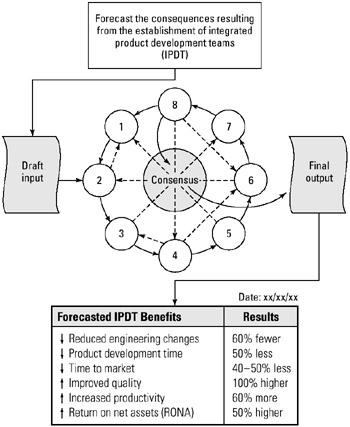Tool 61: Delphi Method
| AKA | Jury of Experts |
| Classification | Evaluating/Selecting (ES) |
Tool description
The Delphi method is a very structured approach used to acquire written opinion or to receive feedback about a problem on detailed questionnaires sent to experts. Used by the Rand Corporation during the 1950s, the use of questionnaires prevents interpersonal interaction that can often stifle individual contribution whenever some participants dominate the discussion. Participants' anonymous responses are shared, and each participant can revise his or her response on the basis of reading other opinions. After repeating this process several times, the convergence of opinion will lead to team consensus.
Typical application
-
To solicit opinions or ideas from a jury of experts, anonymously circulate questionnaires repeatedly for revisions and consolidation in order to arrive at a final forecast, choice, or action plan.
-
To generate ideas by a group of experts, allow them to revise their own ideas after having read all other ideas, and finally have a summarized statement that reflects group consensus.
-
To forecast trends in economic and technological forces that may affect the organization.
Problem-solving phase
| → | Select and define problem or opportunity |
| → | Identify and analyze causes or potential change |
| → | Develop and plan possible solutions or change |
| → | Implement and evaluate solution or change |
| → | Measure and report solution or change results |
| Recognize and reward team efforts |
Typically used by
| Research/statistics | |
| 1 | Creativity/innovation |
| Engineering | |
| Project management | |
| Manufacturing | |
| 3 | Marketing/sales |
| Administration/documentation | |
| Servicing/support | |
| Customer/quality metrics | |
| 2 | Change management |
before
-
Questionnaires
-
Circles of Influence
-
Buzz Group
-
Critical Incident
-
Different Point of View
after
-
Presentation
-
Run-It-By
-
Action and Effect Diagram (AED)
-
What-If Analysis
-
Barriers-and-Aids Analysis
Notes and key points
-
No direct contact, debate, or exchange of information is allowed among the participants.
-
Participants must be given enough time to prevent hasty responses or opinions.
Step-by-step procedure
-
STEP 1 The first activity is to identify and select a team of participants. A trained facilitator coordinates this process and thoroughly explains the Delphi method's objectives and processes to the participants.
-
STEP 2 Participants, isolated from each other, are sent detailed questionnaires, problem statements, or preliminary forecasts for their response or opinion. See example Forecast the Consequences Resulting from the Establishment of Integrated Product Development Teams (IPDT).
-
STEP 3 The completed questionnaires, problem statements, or forecasts are summarized by the facilitator and anonymously redistributed to the participants.
-
STEP 4 Participants read all of the responses. Participants may or may not choose to revise their own response(s).
-
STEP 5 Steps 3 and 4 are repeated until participants stop revising their own responses. At this point, team consensus is reached.
Example of tool application

EAN: 2147483647
Pages: 326